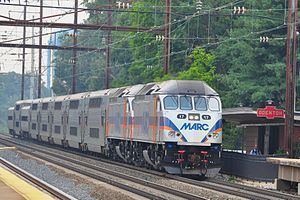Status Operational | Services 1 Stations 13 | |
 | ||
Termini Washington D.C. Union StationPerryville, MD | ||
Onboard marc penn line union station to seabrook
The Penn Line is a MARC commuter rail line running from Union Station, Washington D.C. to Perryville, Maryland via Penn Station, Baltimore, Maryland on Amtrak's Northeast Corridor. It is MARC's busiest and only electric line. Currently the line is the fastest commuter rail line in the country, with trains running at speeds of up to 125 miles per hour (201 km/h). The service is operated under contract by Amtrak which supplies employees to operate trains, and maintains the right-of-way and MARC's electric locomotives and passenger cars. The line is administered by MARC, a service of the Maryland Transit Administration (MTA).
Contents
- Onboard marc penn line union station to seabrook
- Onboard marc penn line seabrook to bwi
- Rolling stock
- Service
- Stations
- References
The Penn Line is the successor to commuter services provided by the Pennsylvania Railroad (PRR), Penn Central, and Conrail as long ago as the mid-19th century. Additionally, Amtrak operated a commuter service named the Chesapeake between 1978–1983. In 1983, Maryland, along with a number of other Northeastern states, took control of its commuter railroads and the "MARC" (Maryland Area Regional Commuter) service name was established. The Penn Line became the replacement for Amtrak's Chesapeake as well as the minimal former PRR commuter service between Washington and Baltimore.
Onboard marc penn line seabrook to bwi
Rolling stock
The Penn Line uses diesel as well as electric locomotives for powering trains. Most electric trains are 5-7 cars long (usually made up of all or mostly Kawasaki bilevels). When the AEM-7s are used, they are usually used in pairs with 5-7 cars because they are significantly older and weaker than the newer HHP-8s. However, when there are only 3-5 cars, only one AEM-7 is used. Rush hour diesel trains are usually 5 cars long (usually made up of all or mostly Kawasaki bilevels). During the day, shorter 3-5 car single level diesel trains from the Brunswick and Camden lines are used on the Penn Line. All weekend Penn Line trains also include a single-level Bike Car that is specially equipped to accommodate bicyclists.
All trains are operated in push-pull configuration (with the cab-car end towards Union Station).
All of the stations from Union Station up to Halethorpe have high-level platforms, and all of the subsequent stations from West Baltimore up to Perryville, with the exception of Penn Station, have low-level platforms. This precludes the use of MARC's ex-Metra low-level boarding gallery railroad cars on the Penn Line.
Service
The Penn Line runs 57 trains during a normal weekday. A majority of these trains (39 each day) originate/terminate from Union Station in Washington and Penn Station in Baltimore. An additional 11 trains originate/terminate from Union Station and Perryville, MD, and another 5 originate/terminate from Union Station and Martin State Airport. A single morning train and a single evening train runs between Perryville and Penn Station. Unlike MARC's other two lines, the Penn Line operates all throughout the day and well into the night.
On December 7, 2013 the Penn Line also began offering limited weekend service. Penn Line weekend service consists of 9 round trips on Saturday and 6 round trips on Sunday—primarily between Penn Station and Union Station, but with some runs extending from/to Martin State Airport. All Penn Line weekend trains include a separate, specially-designed Bike Car which is designed to accommodate bicyclists. Bike Cars are reconditioned Sumitomo/Nippon Sharyo MARC IIA single-level commuter rail cars. One side of each car's interior is lined with bicycle racks which are arranged to secure 23 full-sized, non-collapsible bicycles, and the other side provides seating for 40 passengers. There is no extra charge for using the Bike Car and the bicycle racks on the Bike Car are available on a first-come, first-served basis. The first Bike Car was added to select weekend trains on December 13, 2014. The Bike Car program was expanded in 2015, and since October 31, 2015 all Penn Line weekend trains have offered a Bike Car.
Amtrak's Acela Express, Northeast Regional, and long distance trains share the tracks with the Penn Line and share stations with MARC at Aberdeen, Penn Station, BWI Rail Station, New Carrollton, and Union Station. Currently, MARC passengers with monthly and weekly tickets can ride select Amtrak Northeast Regional trains during the week only. Connections are also available to the Washington Metro Orange Line at New Carrollton, Washington Metro Red Line at Union Station, and to MTA Light Rail at Baltimore Penn Station.
The MTA has plans to extend the Penn Line to Newark, Delaware to connect with the Wilmington/Newark Line of SEPTA, and to also extend the line past Union Station into northern Virginia. The planned Purple Line that will connect all three MARC lines will connect with the Penn Line at New Carrollton.
Stations
The following stations are served by Penn Line trains; not all trains stop at all stations.
